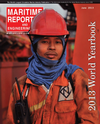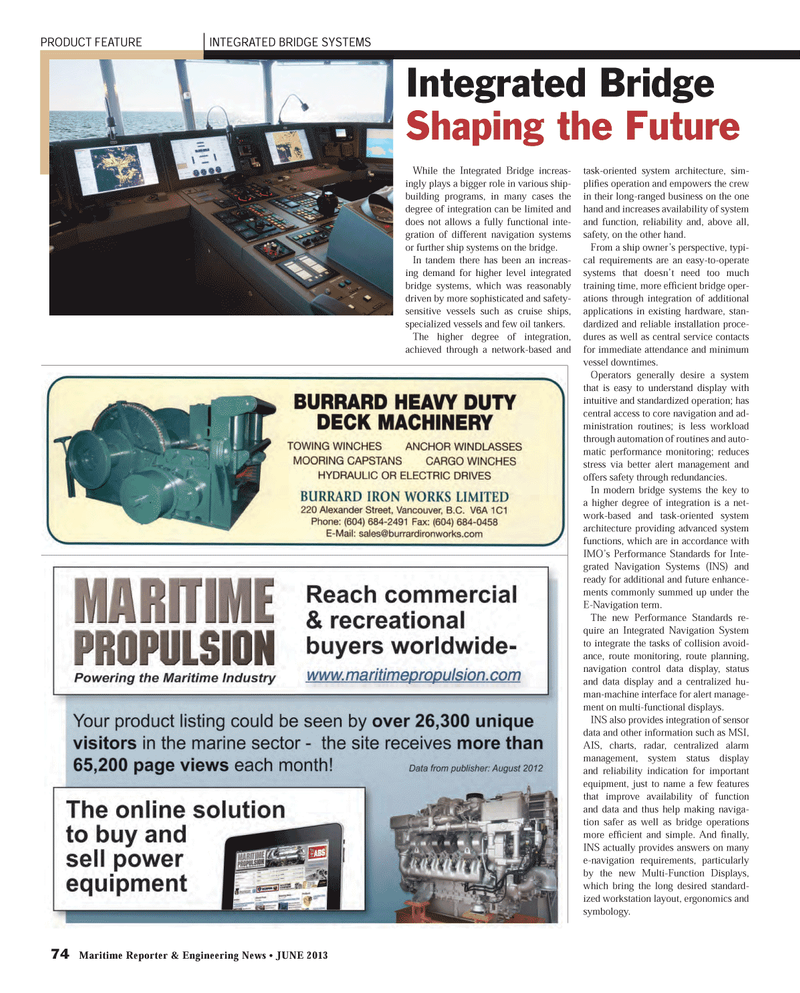
Page 74: of Maritime Reporter Magazine (June 2013)
Annual World Yearbook
Read this page in Pdf, Flash or Html5 edition of June 2013 Maritime Reporter Magazine
74 Maritime Reporter & Engineering News ? JUNE 2013 While the Integrated Bridge increas-ingly plays a bigger role in various ship-building programs, in many cases the degree of integration can be limited and does not allows a fully functional inte-gration of different navigation systems or further ship systems on the bridge. In tandem there has been an increas-ing demand for higher level integrated bridge systems, which was reasonably driven by more sophisticated and safety-sensitive vessels such as cruise ships, specialized vessels and few oil tankers. The higher degree of integration, achieved through a network-based and task-oriented system architecture, sim-pliÞ es operation and empowers the crew in their long-ranged business on the one hand and increases availability of system and function, reliability and, above all, safety, on the other hand. From a ship owner?s perspective, typi- cal requirements are an easy-to-operate systems that doesn?t need too much training time, more efÞ cient bridge oper- ations through integration of additional applications in existing hardware, stan-dardized and reliable installation proce-dures as well as central service contacts for immediate attendance and minimum vessel downtimes. Operators generally desire a system that is easy to understand display with intuitive and standardized operation; has central access to core navigation and ad-ministration routines; is less workload through automation of routines and auto-matic performance monitoring; reduces stress via better alert management and offers safety through redundancies. In modern bridge systems the key to a higher degree of integration is a net-work-based and task-oriented system architecture providing advanced system functions, which are in accordance with IMO?s Performance Standards for Inte- grated Navigation Systems (INS) and ready for additional and future enhance-ments commonly summed up under the E-Navigation term.The new Performance Standards re-quire an Integrated Navigation System to integrate the tasks of collision avoid-ance, route monitoring, route planning, navigation control data display, status and data display and a centralized hu-man-machine interface for alert manage-ment on multi-functional displays. INS also provides integration of sensor data and other information such as MSI, AIS, charts, radar, centralized alarm management, system status display and reliability indication for important equipment, just to name a few features that improve availability of function and data and thus help making naviga-tion safer as well as bridge operations more efÞ cient and simple. And Þ nally, INS actually provides answers on many e-navigation requirements, particularly by the new Multi-Function Displays, which bring the long desired standard-ized workstation layout, ergonomics and symbology. PRODUCT FEATURE INTEGRATED BRIDGE SYSTEMS Integrated Bridge Shaping the Future MR #6 (74-81).indd 74MR #6 (74-81).indd 745/31/2013 10:39:35 AM5/31/2013 10:39:35 AM

 73
73

 75
75
